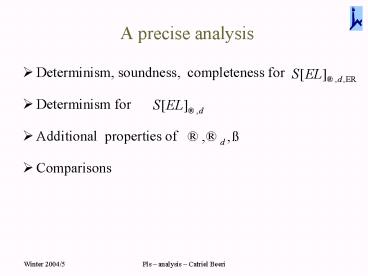A precise analysis - PowerPoint PPT Presentation
Title:
A precise analysis
Description:
A precise analysis. Determinism, soundness, completeness for. Determinism for ... Pls analysis Catriel Beeri. 4. A characterization (if & only if ) of ... – PowerPoint PPT presentation
Number of Views:62
Avg rating:3.0/5.0
Title: A precise analysis
1
A precise analysis
- Determinism, soundness, completeness for
- Determinism for
- Additional properties of
- Comparisons
2
- Analysis for with errors
- Observation
- (determinism for ? for
) - Theme
- Prove by induction on length of selected path
- For the proof, we need some concepts and results
3
- Applicability of rules
- A rule r is applicable (????) to E, if there is a
proof tree for E?E, with r associated with the
root. - A group of rules is applicable to E if one of
them is applicable
Why is it an interesting concept?
Note it is a semantic concept!
4
- A characterization (if only if ) of
applicability - for an application expression E1 E2
- For you Similar characterization for if,
tuple
5
- Q Are the conditions mutually exclusive?
- Q Have we proved determinism?
- Q Have we proved completeness?
- A we still depend on a semantic condition of
having a transition
6
- A reformulation (with some redundancy) of the
(iff ) characterization of applicability (for E1
E2)
7
- By removing the transition condition
- ? mutually exclusive, syntactic, only if
conditions - But, it is still possible that two rules in a
group are applicable, - Or a rule generates more than one transition
8
- Corollary (Inversion)
- If E has a transition, then
- Its primary construct
- value tests for (some) direct sub-expressions
- determine the sub-expression of E that has a
transition - why inversion ?
9
- Observations
- Knowing primary construct of E ? all rules not
for Es expression kind are excluded - Value tests on (some) direct sub-expressions ?
more rules excluded - rules not excluded are potentially applicable
(given current knowledge) - If the remaining rules are proper, they select
a unique direct sub-expression - else, E is a candidate for a reduction
- This leads to the notions of
- selected path selected
sub-expression - (using the conditions in last table)
10
- The selection path in a composite expression E
(for ?d) - Contains its root
- If it contains node n labeled by
- Application n E1 E2, then
- It contains E1 (operator) if E1 is not a value
- It contains E2 (operand) if E2 is not a value,
but E1 is - Stops at n if both E1 E2 are values
- Tuple ..
- If
- Its end is the (root of) the selected
sub-expression of E - As we go down the path, a set of (potentially
applicable) rules is associated with each node,
that all select the same child as next node
11
- Example
- ,
- The condition v1 in Op (1st expr) selects a
unique axiom, then we climb up
Application rules
Non-value
tuple rules
with i 1
applic
Application rules
(apply-op) (apply-error) (app-axioms)
12
- Soundness (determinism) and completeness
(progress) - A composite expression E has a unique proof
tree for a transition, hence a unique
transition. - and
- Es selected sub-expression is a redex, (always
true for the rules with error) - If E ? E (regular), then the
transition for E is E ? E/EE - Else, E ? ER, and also E ? ER
13
- Proof induction on length of selection path
- 0 E is a candidate for a reduction
- always a redex obviously all the
claims hold - Ngt0
- Induction hypothesis claim is true for the
unique child E1 one level down on the
selected path. - The (unique) transition of E1 determines
- a unique applicable rule for E
- hence there is a unique proof
tree/transition for E.
14
- Determinism for
- Can prove directly, using same technique
- Or, recall that
- But, for some expressions, there is no ?d
transition
15
Additional properties
- ? is not a functional relation!
- Possibly many successors to an expression, many
computations - Claim (confluence)
- All ? computations from an expression E
terminate in same final (extended) value - (proof in chapter)
16
- Functionality, Soundness completeness for
natural - For , for each E there is at most
one - applicable rule,
- proof tree,
- value V, s.t.
- Proved by induction on E (we did that already)
- For , replace
- at most by unique
- Value V by XV (V or ER)
- Here, uniqueness of proof tree fails for
derivations of ER, but there is never an
evaluation to a value, another to ER
17
Comparison of transition, natural
-
(w/o ER) -
(with ER)
- The semantics express the
- same intuitive semantics (for
values of expressions) - in different styles
- (which one is easier to write transition or
natural?)































